1993 CADILLAC FLEETWOOD ESP
[x] Cancel search: ESPPage 205 of 386
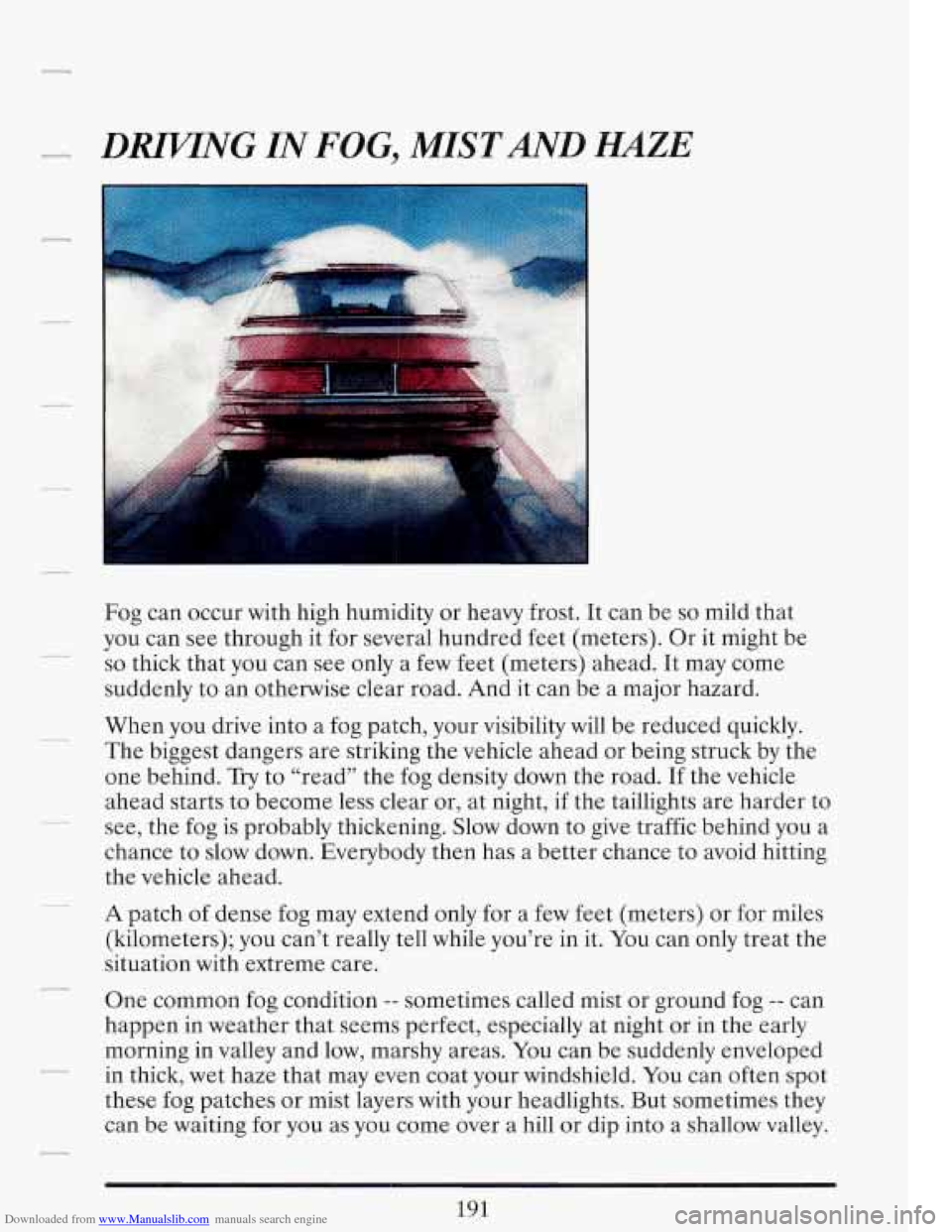
Downloaded from www.Manualslib.com manuals search engine DRZKNG IN FOG, MISTAND HAZE
Fog can occur with high humidity or heavy frost. It can be so mild that
you can see through it for several hundred feet (meters). Or it might be
so thick that you can see only a few feet (meters) ahead. It may come
suddenly to an otherwise clear road. And it can be a major hazard.
When you drive into a fog patch, your visibility will be reduced quickly.
The biggest dangers are striking the vehicle ahead or being struck by the
one behind.
Try to “read” the fog density down the road. If the vehicle
ahead starts to become less clear or, at night,
if the taillights are harder to
see, the fog is probably thickening. Slow down to give traffic behind you a
chance to slow down. Everybody then has a better chance to avoid hitting
the vehicle ahead.
A patch of dense fog may extend only for a few feet (meters) or for miles
(kilometers); you can’t really tell while you’re in it.
You can only treat the
situation with extreme care.
One common fog condition
-- sometimes called mist or ground fog -- can
happen in weather that seems perfect, especially at night or in the early
morning in valley and low, marshy areas.
You can be suddenly enveloped
in thick, wet haze that may even coat your windshield.
You can often spot
these fog patches or mist layers with your headlights. But sometimes they
can
be waiting for you as you come over a hill or dip into a shallow valley.
191
Page 208 of 386

Downloaded from www.Manualslib.com manuals search engine Obey all posted speed limits. But remember that they are for ideal
road, weather and visibility conditions.
You may need to drive below
the posted limit in bad weather or when visibility is especially poor.
Pull to the right (with care) and stop clear of intersections when you
see or hear emergency vehicles.
FREEWAYDMNG
r
-,
Mile for mile, freeways (also called thruways, parkways, expressways,
turnpikes, or superhighways) are the safest of all roads. But they have
their own special rules. 1
The most important advice on freeway driving is: Keep up with traffic and -
keep to the right. Drive at the same speed most of the other drivers are d
driving. Too-fast or too-slow driving breaks a smooth traffic flow. Treat
the left lane on a freeway as a passing lane.
Entering the Freeway
.-
It
At the entrance there is usually a ramp that leads to the freeway. If you
have a clear view of the freeway as you drive along the entrance ramp,
you should begin
to check traffic. Try to determine where you expect to
blend with the flow. If traffic is light, you may have no problem. But
if it is -
heavy, find a gap as you move along the entering lane and time your
approach. Try to merge into the gap at close to the prevailing speed. u
194
Page 221 of 386
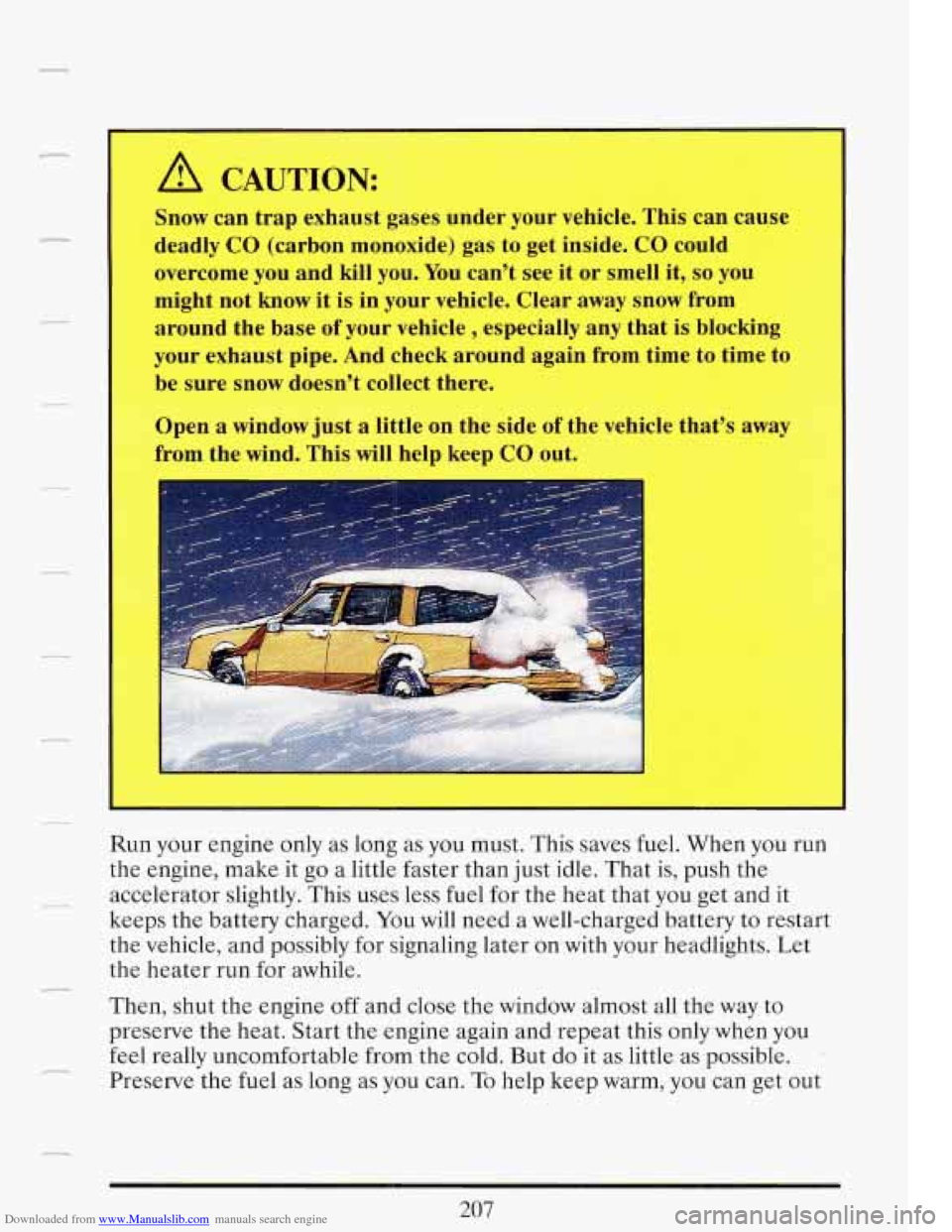
Downloaded from www.Manualslib.com manuals search engine A CAUTION:
Snow can trap exhaust gases under your vehicle. This can cause
deadly CO (carbon monoxide) gas to get inside. CO could
overcome you and kill you. You can’t see it or smell it,
so you
might not know it is in your vehicle. Clear away snow from
around the base
of your vehicle , especially any that is blocking
your exhaust pipe. And check around again from time to time to
be sure snow doesn’t collect there.
Open a window just a little on the side
of the vehicle that’s away
from the wind. This will help keep CO out.
Run your engine only as long as you must. This saves fuel. When you run
the engine, make it go a little faster than just idle. That is, push the
accelerator slightly. This uses less fuel for the heat that you get and it
keeps the battery charged. You
will need a well-charged battery to restart
the vehicle, and possibly for signaling later
on with your headlights. Let
the heater run for awhile.
207
Then, shut the engine off and close the window almost all the way to
preserve the heat. Start the engine again and repeat this only when you
feel really uncomfortable from the cold. But
do it as little as possible.
Preserve the fuel as long as you can. To help keep warm, you can get out
Page 226 of 386
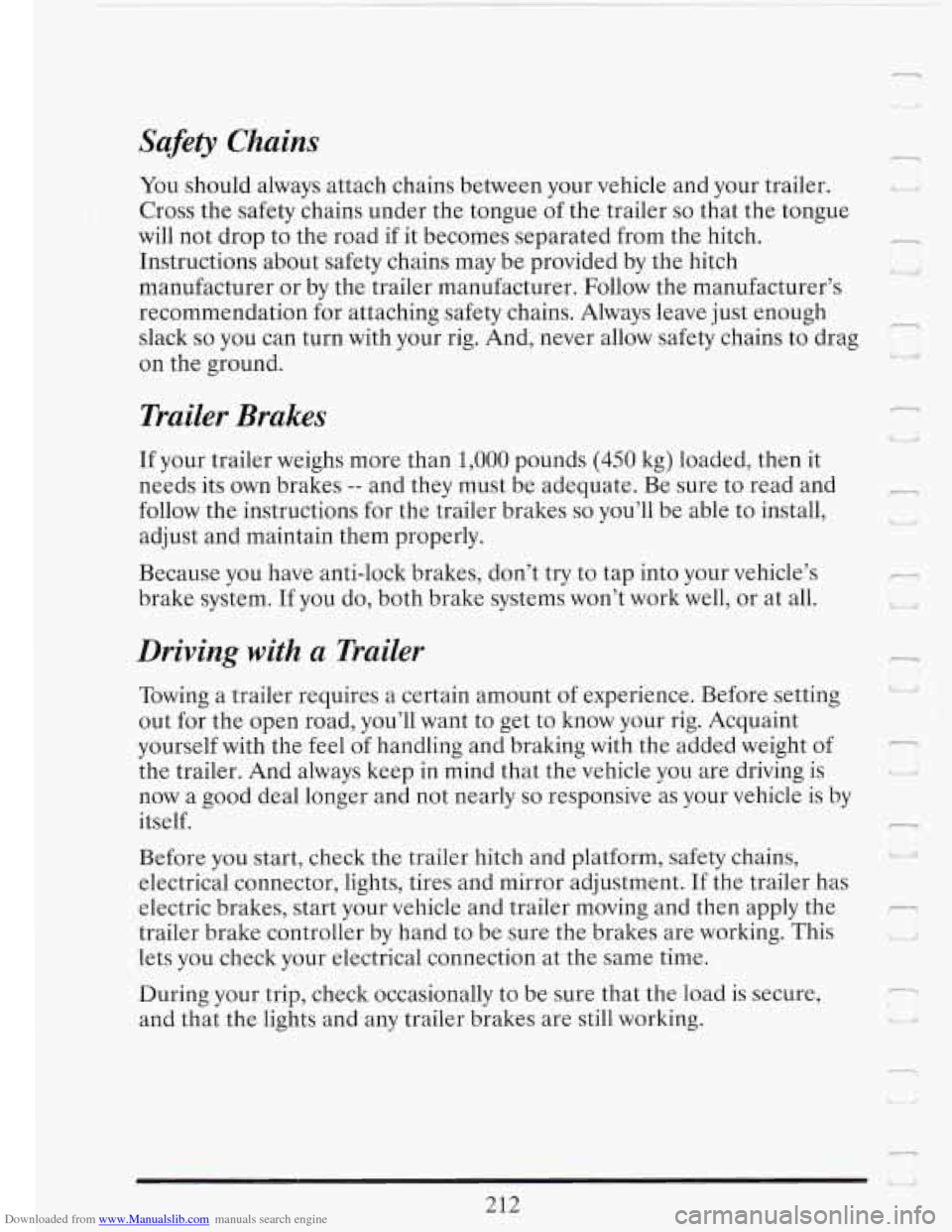
Downloaded from www.Manualslib.com manuals search engine Safety Chains
You should always attach chains between your vehicle and your trailer.
Cross the safety chains under the tongue
of the trailer so that the tongue
will not drop to the road if it becomes separated from the hitch.
Instructions about safety chains may be provided by the hitch
manufacturer or by the trailer manufacturer. Follow the manufacturer’s
recommendation for attaching safety chains. Always leave just enough
slack
so you can turn with your rig. And, never allow safety chains to drag
on the ground.
-
,-
Trailer Brakes
If your trailer weighs more than 1,000 pounds (450 kg) loaded, then it
needs its
own brakes -- and they must be adequate. Be sure to read and
follow the instructions for the trailer brakes
so you’ll be able to install,
adjust and maintain them properly.
Because
you have anti-lock brakes, don’t try to tap into your vehicle’s
brake system. If you do, both brake systems won’t work well, or at all.
Driving with a Trailer
Towing a trailer requires a certain amount of experience. Before setting
out for the open road, you’ll want to get to know your rig. Acquaint
yourself with the feel of handling and braking with the added weight of
the trailer. And always keep
in mind that the vehicle you are driving is
now a good deal longer and not nearly
so responsive as your vehicle is by
itself.
-
Before you start, check the trailer hitch and platform, safety chains, ..
electrical connector, lights, tires and mirror adjustment. If the trailer has
electric brakes, start your vehicle and trailer moving and then apply the
trailer brake controller by hand to be sure the brakes are working. This
lets you check your electrical connection at the same time.
During your trip, check occasionally to be sure that the load
is secure,
and that the lights and any trailer brakes are still working.
212
Page 229 of 386
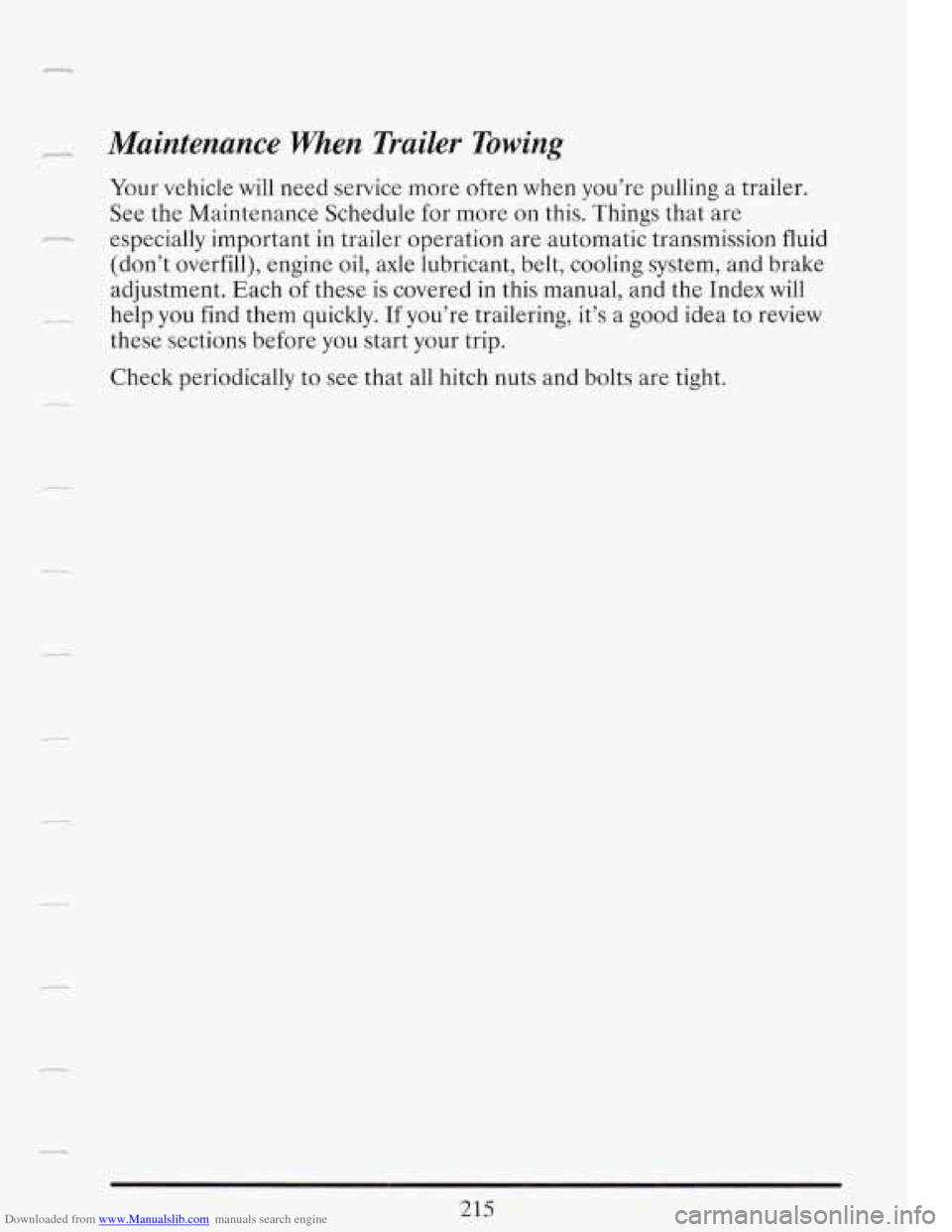
Downloaded from www.Manualslib.com manuals search engine - Maintenance when Trailer Towing
Your vehicle will need service more often when you’re pulling a trailer.
See the Maintenance Schedule for more on this. Things that are
(don’t overfill), engine oil, axle lubricant, belt, cooling system, and brake
adjustment. Each
of these is covered in this manual, and the Index will
__- help you find them quickly. If you’re trailering, it’s a good idea to review
these sections before you start your trip.
Check periodically to see that all hitch nuts and bolts are tight.
rc-.- especially important in trailer operation are automatic transmission fluid
215
Page 251 of 386

Downloaded from www.Manualslib.com manuals search engine 8. Then replace the
pressure cap. Be
sure the arrows on
the pressure cap
line up like this.
IF A TIRE GOES FLAT
-- It’s unusual for a tire to “blow out” while you’re driving, especially if you
maintain your tires properly. If air goes out of a tire, it’s much more likely
to leak out slowly. But
if you should ever have a “blowout,” here are a
If a front tire fails, the flat tire will create a drag that pulls the vehicle
toward that side. Take your foot
off the accelerator pedal and grip the
to a stop well out of the traffic lane.
A rear blowout, particularly on a curve, acts much like a skid and may
remove your foot from the accelerator pedal. Get the vehicle under
control by steering the way you want the vehicle to go. It may be
very
the road if possible.
__ few tips about what to expect and what to do:
__ steering wheel firmly. Steer to maintain lane position, then gently brake
__ require the same correction you’d use in a skid. In any rear blowout,
__ bumpy and noisy, but you can still steer. Gently brake to a stop, well off
If your tire goes flat, the next section shows how to use your jacking
--- equipment to change a flat tire safely.
CHMGING A FLAT TIRE
._- If a tire goes flat, avoid further tire and wheel damage by driving slowly to
a
level place. Turn on your hazard warning flashers.
237
Page 267 of 386
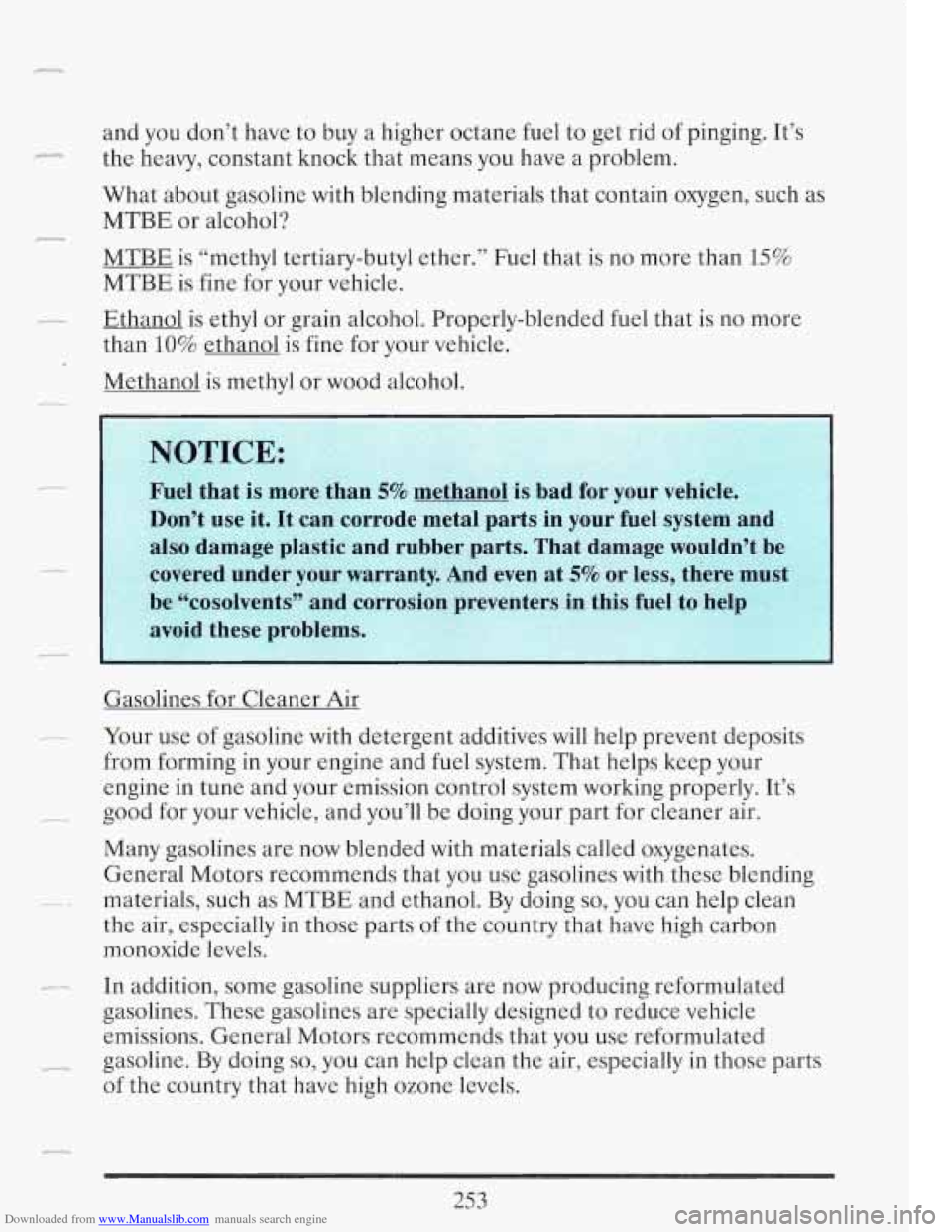
Downloaded from www.Manualslib.com manuals search engine r
J
r
and you don’t have to buy a higher octane fuel to get rid of pinging. It’s
the heavy, constant knock that means you have
a problem.
What about gasoline with blending materials that contain oxygen, such as
MTBE or alcohol?
MTBE is “methyl tertiary-butyl ether.’’ Fuel that is no more than
15%
MTBE is fine for your vehicle.
Ethanol is ethyl or grain alcohol. Properly-blended fuel that is no more
than
10% ethanol is fine for your vehicle.
Methanol is methyl or wood alcohol.
Gasolines for Cleaner &r
.. -- Your use of gasoline with detergent additives will help prevent deposits
from forming in your engine and fuel system. That helps keep your
engine
in tune and your emission control system working properly. It’s
~ good for your vehicle, and you’ll be doing your part for cleaner air.
Many gasolines are now blended with materials called oxygenates.
General Motors recommends that you use gasolines with these blending
. materials, such as MTBE and ethanol. By doing so, you can help clean
the air, especially in those parts of the country that have high carbon
monoxide levels.
c- In addition, some gasoline suppliers are now producing reformulated
- gasoline. By doing so, you can help clean the air, especially in those parts
gasolines.
These gasolines are specially designed to reduce vehicle
emissions. General Motors recommends that you use reformulated
of the country that have high ozone levels.
253
Page 280 of 386
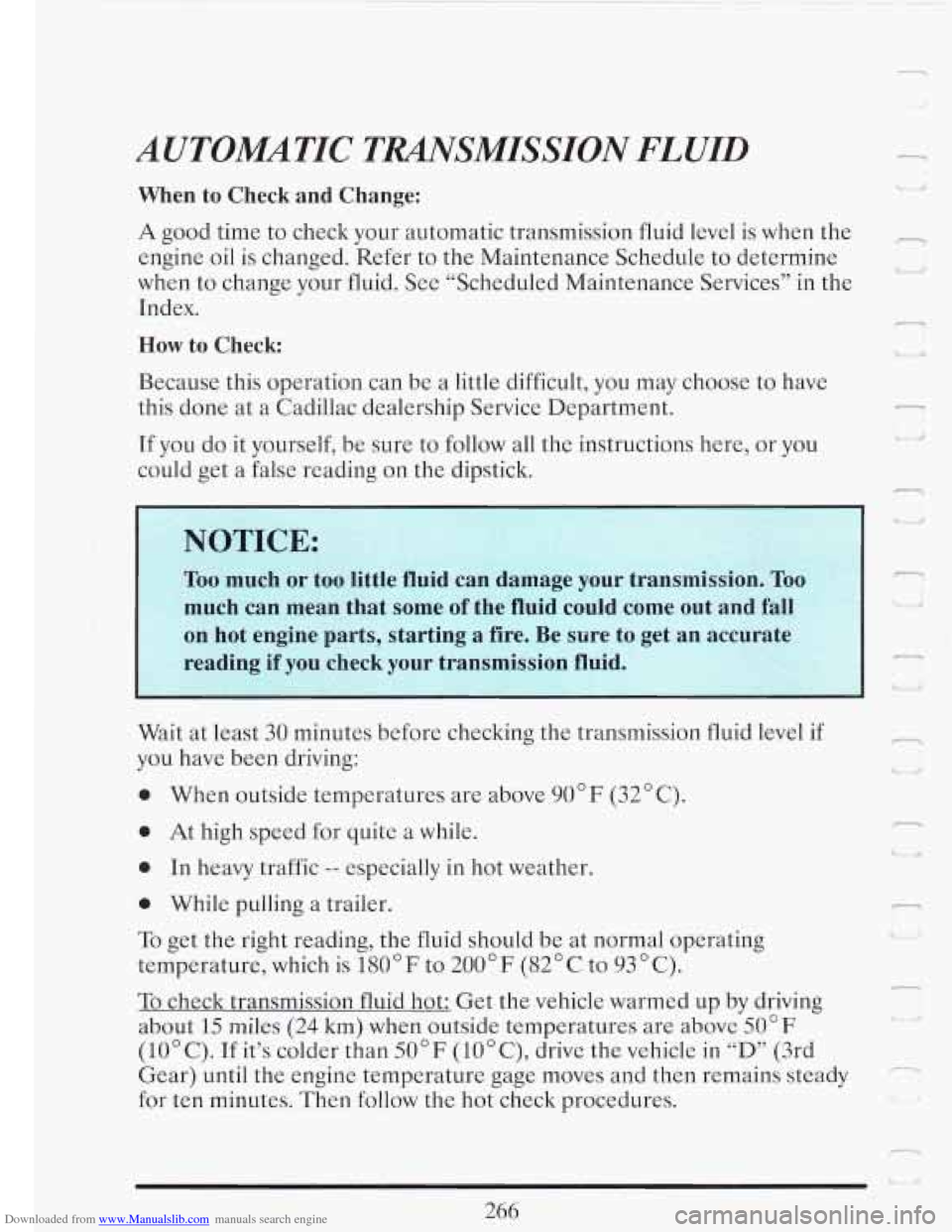
Downloaded from www.Manualslib.com manuals search engine AUTOMATIC TMSMISSION FLUID
When to Check and Change:
A good time to check your automatic transmission fluid level is when the
engine oil is changed. Refer to the Maintenance Schedule to determine
cpr
when to change your fluid. See “Scheduled Maintenance Services’’ in the
Index. -I
How to Check
BeC’%’uSe this operation can be a little difficult, you may choose to have
this done at a Cadillac dealership Service Department.
r IYI
”I If you do it yourself, be sure to follow all the instructions here, or you
could get a false reading on the dipstick.
p_
NOTICE:
I
Too much or too little fluid can damage your transmission.
much can mean that some of the fluid could come out and fall
on hot engine parts, starting
a fire. Be sure to get an accurate
reading if you check
your transmission fluid. I
l-
Wait at least 30 minutes before checking the transmission fluid level if
you have been driving:
0 When outside temperatures are above 90” F (32” C).
n !‘ b
0 At high speed for quite a while.
0 In heavy traffic -- especially in hot weather.
0 While pulling a trailer.
To get the right reading, the fluid should be at normal operating
temperature, which is
180°F to 200°F (82°C to 93OC).
To check transmission fluid hot: Get the vehicle warmed up by driving
about
15 miles (24 km) when outside temperatures are above 50°F
(10°C). If it’s colder than 50°F (lO°C), drive the vehicle in “D” (3rd
Gear) until the engine temperature gage moves and then remains steady
-
for ten minutes. Then follow the hot check procedures. t3
_L-
1 <- 1
266